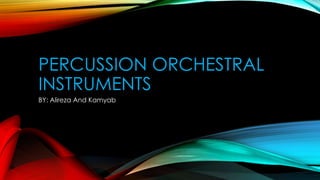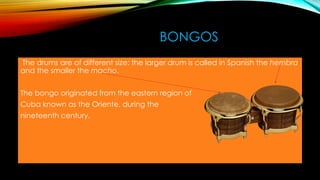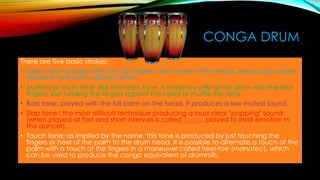Percussion orchestral instruments
- 1. PERCUSSION ORCHESTRAL INSTRUMENTS BY: Alireza And Kamyab
- 2. TIMPANI/KETTLEDRUMS ? A type of drum, they consist of a skin called a head stretched over a large bowl traditionally made of copper. ? They are played by striking the head with a specialized drum stick called atimpani stick or timpani mallet.
- 3. TIMPANI/KETTLEDRUMS QUIZ What is the skin made of and called? Copper and its called the head What is the specialized drum stick called? atimpani or timpani stick
- 4. CYMBALS ? Cymbals are mostly used in the orchestra, jazz bands, heavy metal bands. ? Cymbals are measured by their diameter often in inches or centimeters. The size of the cymbal affects its sound, larger cymbals usually being louder and having longer sustain.
- 5. CYMBALS QUIZ What are cymbals measured by? Their diameter What effects the cymbals sound by making it louder? The size of the cymbals
- 6. SNARE DRUMS A typical diameter for snare drums is 36cm. Most of snare drums are made of wood and metal There are many types of snare drums, including: ? Marching snare ? Drum kit snare ? Piccolo snare ? Maracatu snare ? Tarol
- 7. SNARE DRUMS QUIZ Name three type of snare drums? Marching snare, Drum kit snare, Piccolo snare, Maracatu snare, Tarol What is he typical diameter of a snare drum? 36cm
- 8. TAMBOURINE ? The frame is often made of wood or plastic ? The metal jingles are called zils
- 9. TAMBOURINE QUIZ What is the frame mostly made of? Wood/plastic What are the jingles called? zils
- 10. BONGOS The drums are of different size: the larger drum is called in Spanish the hembra and the smaller the macho. The bongo originated from the eastern region of Cuba known as the Oriente, during the nineteenth century.
- 11. BONGOS QUIZ What is the big drum called? Hembra What is the smaller drum called? Macho Bongos were originated in …………. Cuba-oriente When ? 19th century
- 12. XYLOPHONE ? The xylophone (from the Greek words ξ?λον—xylon, "wood" + φων?—phonē, "sound, voice", meaning "wooden sound")
- 13. XYLOPHONE QUIZ Where is xylophone from? Greece What does xylon mean? Wood What does phone(in greek) mean? sound
- 14. BASS DRUM A bass drum is typically cylindrical with the diameter much greater than the height. Bass drums are too large to be hand held and are always mounted in some way. The usual ways of mounting a bass drum are: Using a shoulder. On a floor stand as part of a drum kit.
- 15. BASS DRUM QUIZ Which one is greater the height or the diameter? Diameter Two ways of holding the bass drum…….. On the floor as a drum kit Using a shoulder
- 16. GONG It originated in China and later spread to Southeast Asia, and it may also be used in the percussion section of Western symphony orchestra.
- 17. GONG QUIZ Where was the gong originated? china
- 18. CONGA DRUM There are five basic strokes: ? Open tone :played with the four fingers near the rim of the head, producing a clear resonant tone with a distinct pitch. ? Muffled or mute tone :like the open tone, is made by striking the drum with the four fingers, but holding the fingers against the head to muffle the tone. ? Bass tone: played with the full palm on the head. It produces a low muted sound. ? Slap tone : the most difficult technique producing a loud clear "popping" sound (when played at fast and short intervals is called floreo, played to instill emotion in the dancer). ? Touch tone: as implied by the name, this tone is produced by just touching the fingers or heel of the palm to the drum head. It is possible to alternate a touch of the palm with a touch of the fingers in a maneuver called heel-toe (manoteo), which can be used to produce the conga equivalent of drumrolls.
- 19. CONGA DRUM QUIZ Name five different strokes Open tone Muffled or mute tone Bass tone Slap tone Touch tone
- 20. NOW CAN YOU NAME 9 DIFFERENT PERCUSSION INSTRUMUENTS USED IN THE ORCHESTRA ? Kettle/timpani ? Gong ? Conga ? Cymbals ? Bass drums ? Xylophone ? Conga drum ? Snare drums ? bongos




















